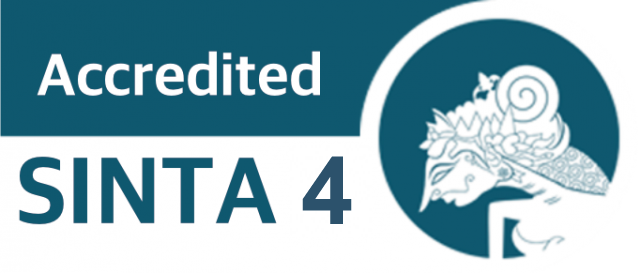OPTIMASI HYPERPARAMETER CONVOLUTIONAL NEURAL NETWORK UNTUK KLASIFIKASI PENYAKIT TANAMAN PADI
Abstract
Plant disease is a challenge in the agricultural sector, especially for rice farmers. Identification of diseases on rice leaves is the first step to eradicating and treating diseases, to minimize crop failure. With the rapid development of the convolutional neural network (CNN), rice leaf disease can be recognized well without the help of an expert. The MobileNet-V2 architecture is used to classify rice leaf diseases due to its small size but good performance. To improve the performance of the CNN model, a hyperparameter consisting of an epoch, batch size, learning rate, and optimizer. This study purpose to have hyperparameters optimal The dataset used consists of 3 classes of diseases that attack the leaves of rice plants, including blast, blight, and tungro. Based on the experiments that have been carried out, the determination of hyperparameters greatly influences the model performance. Hyperparameter with epochs, batch sizes 32 learning rate and optimizer gives the most optimal results with accuracy 97.56%, precision 97.64%, recall 97.57%, and f1-score 97.57%.
References
[2] F. Martinelli et al., “Advanced methods of plant disease detection. A review,” Agron. Sustain. Dev., vol. 35, no. 1, pp. 1–25, 2015, doi: 10.1007/s13593-014-0246-1.
[3] M. Turkoglu and D. Hanbay, “Apricot Disease Identification based on Attributes Obtained from Deep Learning Algorithms,” 2018 Int. Conf. Artif. Intell. Data Process. IDAP 2018, no. September 2018, 2019, doi: 10.1109/IDAP.2018.8620831.
[4] J. G. A. Barbedo, “Digital Image Processing for Detecting and Classifying Plant Diseases,” Springerplus, vol. 2, 2013, doi: 10.22632/ccs-2017-252-66.
[5] F. Jiang, Y. Lu, Y. Chen, D. Cai, and G. Li, “Image recognition of four rice leaf diseases based on deep learning and support vector machine,” Comput. Electron. Agric., vol. 179, no. October, p. 105824, 2020, doi: 10.1016/j.compag.2020.105824.
[6] R. P. Ramadhan and N. L. Marpaung, “Identifikasi jenis penyakit daun tanaman jagung menggunakan jaringan saraf tiruan berbasis backpropagation,” Jom FTEKNIK, vol. 6, no. 1, pp. 1–5, 2019.
[7] S. Kumar et al., “Chest X ray and cough sample based deep learning framework for accurate diagnosis of COVID-19,” Comput. Electr. Eng., vol. 103, p. 108391, 2022, doi: 10.1016/j.compeleceng.2022.108391.
[8] N. F. F. Alshdaifat, A. Z. Talib, and M. A. Osman, “Improved deep learning framework for fish segmentation in underwater videos,” Ecol. Inform., vol. 59, 2020, doi: 10.1016/j.ecoinf.2020.101121.
[9] Y. Yuan, L. Chen, H. Wu, and L. Li, “Advanced agricultural disease image recognition technologies: A review,” Inf. Process. Agric., pp. 1–12, 2021, doi: 10.1016/j.inpa.2021.01.003.
[10] Y. LeCun et al., “Backpropagation Applied to Handwritten Zip Code Recognition,” Neural Comput., vol. 1, no. 4, pp. 541–551, 1989, doi: 10.1162/neco.1989.1.4.541.
[11] J. W. G. Putra, Pengenalan Konsep Pembelajaran Mesin dan Deep Learning, vol. 4. 2020.
[12] Y. Lu, S. Yi, N. Zeng, Y. Liu, and Y. Zhang, “Identification of rice diseases using deep convolutional neural networks,” Neurocomputing, vol. 267, pp. 378–384, Dec. 2017, doi: 10.1016/j.neucom.2017.06.023.
[13] S. Ghosal and K. Sarkar, “Rice Leaf Diseases Classification Using CNN With Transfer Learning,” in 2020 IEEE Calcutta Conference, Feb. 2020, pp. 230–236, doi: 10.1109/CALCON49167.2020.9106423.
[14] R. R. and D. Park, “A Multiclass Deep Convolutional Neural Network Classifier for Detection of Common Rice Plant Anomalies,” Int. J. Adv. Comput. Sci. Appl., vol. 9, no.1, pp. 67–70, 2018, doi: 10.14569/IJACSA.2018.090109.
[15] J. Chen, J. Chen, D. Zhang, Y. Sun, and Y. A. Nanehkaran, “Using deep transfer learning for image-based plant disease identification,” Comput. Electron. Agric., vol. 173, no. November 2019, p. 105393, Jun. 2020, doi: 10.1016/j.compag.2020.105393.
[16] A. Julianto and A. Sunyoto, “A performance evaluation of convolutional neural network architecture for classification of rice leaf disease,” IAES Int. J. Artif. Intell., vol. 10, no. 4, pp. 1069–1078, 2021, doi: 10.11591/IJAI.V10.I4.PP1069-1078.
[17] R. Riswandi, R. Jamiah, N. Mardhatillah, and H. P. Hamid, “Klasifikasi Penyakit Pada Citra Daun Jeruk Menggunakan Arsitektur MobileNet berbasis Mobile Platform,” J. Fokus Elektroda Energi List. Telekomun. Komputer, Elektron. dan Kendali), vol. 6, no. 4, p. 212, 2021, doi: 10.33772/jfe.v6i4.19113.
[18] Putri Teresia Ompusunggu;, “Klasifikasi Penyakit Tanaman Pada Daun Kentang Dengan Metode Convolutional Neural Network Arsitektur Mobilenet,” J. Syntax Fusion, vol. 2, no. 9, pp. 740–751, 2022, doi: 10.54543/fusion.v2i09.217.
[19] F. Hutter, L. Kotthoff, and J. Vanschoren, Automated machine learning: methods, systems, challenges. Springer Nature, 2019.
[20] P. Lacerda, B. Barros, C. Albuquerque, and A. Conci, “Hyperparameter optimization for COVID-19 pneumonia diagnosis based on chest CT,” Sensors, vol. 21, no. 6, pp. 1–11, 2021, doi: 10.3390/s21062174.
[21] A. E. Minarno, M. Hazmi Cokro Mandiri, Y. Munarko, and H. Hariyady, “Convolutional Neural Network with Hyperparameter Tuning for Brain Tumor Classification,” Kinet. Game Technol. Inf. Syst. Comput. Network, Comput. Electron. Control, vol. 4, 2021, doi: 10.22219/kinetik.v6i2.1219.
[22] I. G. T. Isa and B. Junedi, “Hyperparameter Tuning Epoch Dalam Meningkatkan Akurasi Data Latih Dan Data Validasi Pada Citra Pengendara,” Pros. Semin. Nas. Sains dan Teknol., vol. 12, no. 1, pp. 231–237, 2022.
[23] Y. N. Fuadah, I. D. Ubaidullah, N. Ibrahim, F. F. Taliningsing, N. K. Sy, and M. A. Pramuditho, “Optimasi Convolutional Neural Network dan K-Fold Cross Validation pada Sistem Klasifikasi Glaukoma,” ELKOMIKA J. Tek. Energi Elektr. Tek. Telekomun. Tek. Elektron., vol. 10, no. 3, p. 728, 2022, doi: 10.26760/elkomika.v10i3.728.
[24] N. Rochmawati, H. B. Hidayati, Y. Yamasari, H. P. A. Tjahyaningtijas, W. Yustanti, and A. Prihanto, “Analisa Learning Rate dan Batch Size pada Klasifikasi Covid Menggunakan Deep Learning dengan Optimizer Adam,” J. Inf. Eng. Educ. Technol., vol. 5, no. 2, pp. 44–48, 2021, doi: 10.26740/jieet.v5n2.p44-48.
[25] D. Motta et al., “Optimization of convolutional neural network hyperparameters for automatic classification of adult mosquitoes,” PLoS One, vol. 15, no. 7, pp. 1–30, 2020, doi: 10.1371/journal.pone.0234959.
[26] S. Bhattacharya, A. Mukherjee, and S. Phadikar, “A Deep Learning Approach for the Classification of Rice Leaf Diseases,” Adv. Intell. Syst. Comput., vol. 1109, no. May 2020, pp. 61–69, 2020, doi: 10.1007/978-981-15-2021-1_8.
[27] A. A. J. V. Priyangka and I. M. S. Kumara, “Classification Of Rice Plant Diseases Using the Convolutional Neural Network Method,” Lontar Komput. J. Ilm. Teknol. Inf., vol. 12, no. 2, p. 123, 2021, doi: 10.24843/lkjiti.2021.v12.i02.p06.
[28] W. Widystuti and J. B. B. Darmawan, “Pengaruh jumlah data set terhadap akurasi pengenalan dalam deep convolutional network,” Konf. Nas. Sist. Inf., pp. 8–9, 2018.
[29] M. Sandler, A. Howard, M. Zhu, A. Zhmoginov, and L. C. Chen, “MobileNetV2: Inverted Residuals and Linear Bottlenecks,” Proc. IEEE Comput. Soc. Conf. Comput. Vis. Pattern Recognit., pp. 4510–4520, 2018, doi: 10.1109/CVPR.2018.00474.
[30] C. Manliguez, “Generalized Confusion Matrix for Multiple Classes,” no. November, pp. 5–7, 2016, doi: 10.13140/RG.2.2.31150.51523.
[31] D. Zhang, J. Wang, and X. Zhao, “Estimating the Uncertainty of Average F1 Scores,” in Proceedings of the 2015 International Conference on The Theory of Information Retrieval, Sep. 2015, pp. 317–320, doi: 10.1145/2808194.2809488.
[32] Faiz Nashrullah, Suryo Adhi Wibowo, and Gelar Budiman, “The Investigation of Epoch Parameters in ResNet-50 Architecture for Pornographic Classification,” J. Comput. Electron. Telecommun., vol. 1, no. 1, pp. 1–8, 2020, doi: 10.52435/complete.v1i1.51.
[33] S. N. Rahmawati, E. W. Hidayat, and H. Mubarok, “Implementasi Deep Learning Pada Pengenalan Aksara Sunda Menggunakan Metode Convolutional Neural Network,” Inser. Inf. Syst. Emerg. Technol. J., vol. 2, no. 1, p. 46, 2021, doi: 10.23887/insert.v2i1.37405.
Copyright (c) 2022 TEKNIMEDIA: Teknologi Informasi dan Multimedia

This work is licensed under a Creative Commons Attribution-ShareAlike 4.0 International License.
Semua tulisan pada jurnal ini menjadi tanggungjawab penuh penulis. Jurnal Teknimedia memberikan akses terbuka terhadap siapapun agar informasi dan temuan pada artikel tersebut bermanfaat bagi semua orang. Jurnal Teknimedia dapat diakses dan diunduh secara gratis, tanpa dipungut biaya, sesuai dengan lisensi creative commons yang digunakan.

Jurnal TEKNIMEDIA : Teknologi Informasi dan Multimedia is licensed under a Lisensi Creative Commons Atribusi-BerbagiSerupa 4.0 Internasional


.png)





